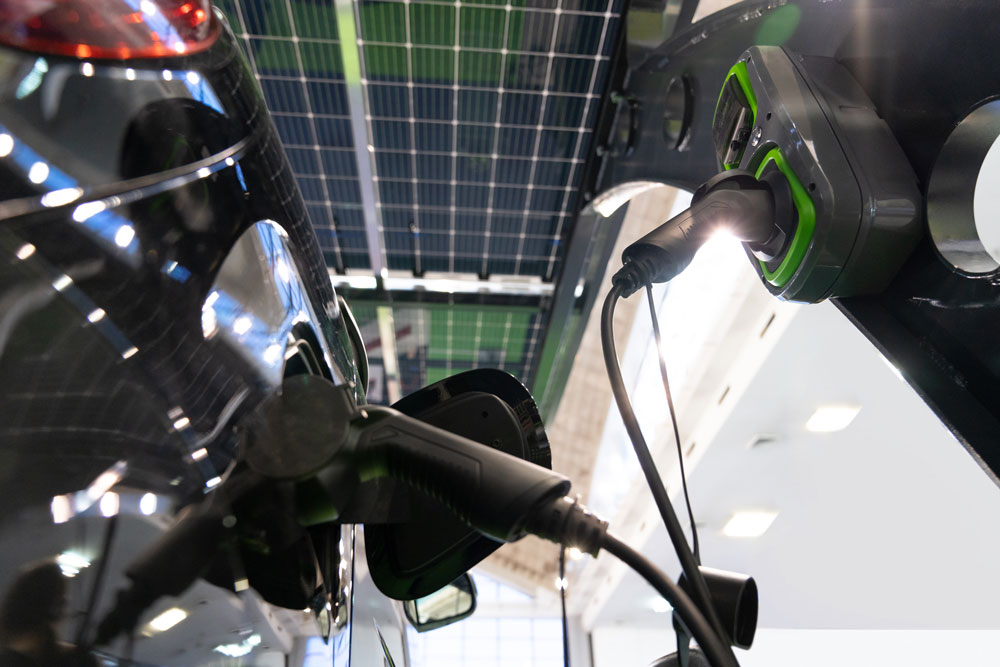Creating a charging eco-system

Solar carports, alongside integrated EV chargers, allow businesses to generate their own electricity on site and use it directly to power electric fleets. Here’s how the UK is embracing this innovation
As fleet operators across the UK prepare for a zero-emission future, solar carports are emerging as a powerful tool in the transition – not just as a clean energy source, but as a way to bring charging and energy generation together in a single, cost-effective, and scalable solution. As energy costs rise and infrastructure demands grow, solar carports offer a compelling solution.
At their core, solar carports convert underused outdoor parking spaces into energy-producing assets. With the option of integrated EV chargers, they allow businesses to generate their own electricity on site and use it directly to power electric fleets, significantly cutting both carbon emissions and reliance on the grid. The technology also builds long-term cost stability by insulating organisations from volatile electricity prices.
Government interest in solar
Recent government interest has further accelerated the conversation around solar canopies. A now-closed consultation explored the potential for mandating solar installations in new outdoor car parks for both public and private organisations, alongside reforms to planning rules for EV charging infrastructure. Energy Secretary Ed Miliband made the policy direction clear, saying that the UK should harness the energy potential of the nation’s parking spaces to power homes, businesses and transport.
While the UK explores its next steps, countries like France and Slovenia are already leading the way, requiring solar carports in large-scale parking facilities. Here at home, real-world projects are proving that the business case stacks up. An 80-space car park can save an estimated £28,000 annually if all electricity generated is used on site. And that doesn’t account for the benefits of battery storage, grid export, or future vehicle-to-grid models.
Solar in action
In Leeds, the Stourton Park & Ride has become the UK’s first fully solar-powered park and ride facility, backed by a comprehensive renewable energy system. Its 1.2 MW solar carport installation is paired with high-spec EV chargers, smart grid integration, and a 500 kW Tesla battery. Designed with a future-ready mindset, the project incorporates SunPower Maxeon high-efficiency panels, curved carport structures, and behind-the-meter energy storage to reduce energy export and maximise on-site consumption. The system is expected to offset 471 tonnes of CO2 in its first year, equivalent to removing over 200 vehicles from the road.
In Milton Keynes, Dawsongroup vans has built a solar-powered microgrid around a 262 kWp solar carport system supporting 34 EV chargers and 300 kWh of battery storage.
The system stores energy for later use, balances loads via a smart energy management platform, and is expected to cut 65 tonnes of CO2 per year, all while helping the company deliver zero-emission vehicles to customers more efficiently.
The NHS is also embracing this approach. Eastbourne District General Hospital’s new solar carport installation spans over 2,400 panels and covers 400 parking bays. With a capacity to generate 1,000 MWh per year and power ten EV chargers, the system is set to reduce annual carbon emissions by 222 tonnes. It forms part of a broader energy strategy that includes upgrades to insulation, lighting and heating systems across the Trust.
Meanwhile, Scunthorpe Hospital is replacing its existing staff car park with one covered with solar panels. It is part of a £27 million project to reduce the hospital’s carbon emissions by more than 4,000 tonnes a year.
Education providers are also exploring the long-term value of solar carports. At Mid Kent College, a major solar installation is part of a campus-wide zero carbon strategy. The project combines rooftop PV, solar façades, battery storage and carports to generate over 310,000 kWh annually. It also creates educational opportunities, with the live energy system acting as a teaching resource for students learning about sustainable technologies and infrastructure.
Financial returns
Beyond environmental benefits, these projects are proving that solar carports can deliver strong financial returns. In Leeds, modelling on its Stourton Park & Ride shows that the EV charging infrastructure could achieve payback in under 10 years, even with modest usage. The addition of battery storage helps flatten peak demand, extend battery life, and smooth out the intermittency of solar generation – providing operational predictability that’s critical for high-usage fleets.
With the right planning policies and financial support, solar carports could become a foundational part of the UK’s clean transport and energy future. For fleet managers, they offer a platform for decarbonisation, energy independence and long-term savings.






